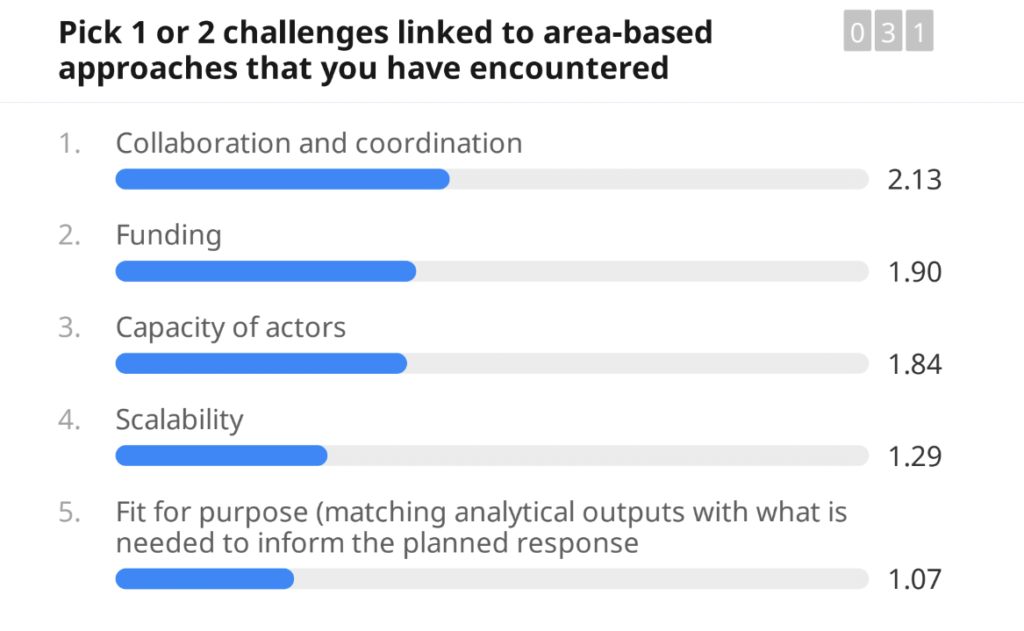Area-based approaches, initially developed for urban contexts, marked a paradigm shift in humanitarian assistance. They called for a move away from assistance focused on the individual beneficiary or target population group, to responses that consider the larger geographical scale. They recognize the need to consider all population groups in an area, as well as the complex existing systems in place, such as services and governance structures. Area-based approaches to analysis, thus, build on a methodology that is inclusive of all populations, sectors and relevant stakeholders and uses a specific geographic area as entry point, in order to inform a more holistic understanding. Area-based approaches also help advance whole-of-society Solutions – one of the key pillars of the United Nations Secretary-General’s Action Agenda on Internal Displacement.
The fifth edition of the series of practitioner-centered webinars by JIPS and the Durable Solutions Learning Community looks at how area-based approaches are operationalized, specifically in displacement studies that include an analysis of Durable Solutions.
https://youtu.be/9YlvfnYmnqM
More than 100 participants joined the exchange, in which Ola Samarah, Information Management Specialist at JIPS; Louise Thaller, Area-Based Assessment and Response Planning Specialist at IMPACT Initiatives; and Sophos Sophianos, Urban Planner at UN-Habitat, discussed key methodology elements and lessons from area-based displacement studies in Syria, Niger and Somalia.
In Niger, a series of area-based durable solutions analyses were conducted to plan relief, recovery and longer-term development investment in newly built urban neighborhoods housing displacement-affected communities. In Somalia, urban area-based studies informed community-based planning for small-scale projects to improve basic service delivery. In Syria, the approach aimed at providing cities and actors from both the humanitarian and recovery fields with information on the functionality of the city systems and the magnitude of displacement to help in positioning response along the humanitarian-development-peace nexus.
In all three case studies there was a strong emphasis on contributing to an integrated response within the humanitarian, development, and peace nexus – bringing all sectors and stakeholders together was key. Different qualitative and quantitative methods, including mapping of the areas, were used, while all studies included an analysis of the displacement impact on the populations and the target area.
“Area-based approaches in our perspective, are really a way to operationalize those two commitments [the nexus and localization], that are about working more closely with local and development actors to find longer-term Solutions beyond humanitarian response. The underlying goal of any area-based assessments is to bring all actors together to agree on Solutions.
– Louise Thaller, IMPACT Initiatives
In Somalia and Niger, the studies concentrated on the shared challenges of the displaced and non-displaced communities, which was typically access to services, while also identifying displacement specific challenges, e.g. tenure insecurity. In Somalia, the analysis pointed to the need to focus response on upgrading existing neighborhoods and support integration of displaced households, rather than only trying to resettle at scale.
In Syria, a different approach was taken comparing the pre-conflict to the post-conflict situation of cities, including the urban trends and regional context of the city, the magnitude of forced displacement and the factors that hinder or support progress towards Durable Solutions. Ola Samarah furthermore explained how the analysis captured the interdependencies between the different city systems, and how the (lack of) functionality of one system affected the functionality of the other systems.
Localisation through engagement with communities and authorities was a defining feature in both Niger and Somalia. For instance in Somalia, Community Facilitation Teams were created to lead the Action Planning, and the most recent editions of the urban profiles in South West and Jubaland are done in cooperation with the State Ministries of Public Works. One of the key lessons shared by Sophos Sophianos (UN-Habitat), was the need to integrate capacity building for public servants to support facilitation of local solutions and increase community acceptance and government legitimacy. From the Niger case study, Louise Thaller (IMPACT) highlighted the importance of the participatory planning aspect as a core element of an area-based approach, and shared one of the unintended positive impacts from the studies being the capacity building for municipal governments done as part of the process.
At the end of the webinar, both participants and panelists offered reflections on key challenges linked to area-based approaches. Collaboration and coordination, as well as funding were highlighted as areas in need of enhanced practice by participants (see figure below).

Panelists raised similar lessons learned from their use cases, underscoring the need for capacity building as a key element of the implementation of an area-based analysis, to ensure sustainability and possibility to replicate approaches.
“The capacity-building of actors is really important. Capabilities are a core component of the approach, not only towards the tools, methodologies, and the analysis, but also to ensure uptake of the products and the sustainability of the work.”
– Ola Samarah, JIPS
We look forward to critically reflecting and brainstorming around solutions to the key challenges linked to area-based approaches in future Durable Solutions Learning Community webinars to continue collectively enhancing our practice.
The Durable Solutions Analysis Learning Community constitutes part III of the interagency Durable Solutions project, a multi-stakeholder initiative led by the Special Rapporteur on the human rights of IDPs. Made possible through generous funding by the US Bureau of Population, Refugees, and Migration (BPRM), it builds off the experiences from putting the Interagency Durable Solutions Indicator Library and Analysis Guide as well as other tools into practice.
We hope that this discussion and the learning community more broadly speaking, will help improve our collective practice in the area of Durable Solutions analysis, as well as provide useful input for the High-Level Panel on Internal Displacement and the multi-stakeholder efforts of the GP20 initiative.
Feel free to get in touch at info@jips.org for any thoughts or questions you may have, or if you wish to be added to the Durable Solutions Analysis Learning Community Skype group. You can also sign up to our newsletter to stay informed.